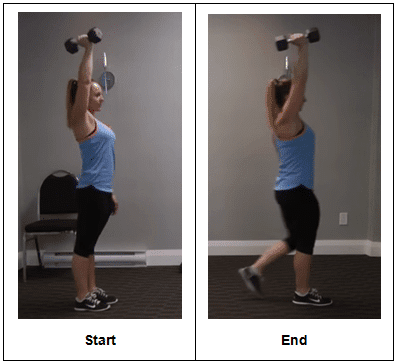
The shoulder is one of the most complicated areas of your body. It’s a ball-and-socket joint, allowing it to move in all directions, and it also allows you to rotate your arm 360 degrees around the axis. It’s also known as one of the “throwing shoulders,” meaning it’s responsible for throwing motions. As a result, the shoulder is involved in tasks like lifting and rotating, which makes it one of the most unstable joints in humans.
If you have any trouble with stability or mobility in your shoulders, there are ways.
In this video, I wanted to go through a great exercise that will help improve the stability of your shoulder.
CLICK HERE to watch the YouTube video.
The shoulder is the most mobile joint in the body, and, as such, it is inherently unstable. For this reason, the shoulder frequently becomes injured. The shoulder must be stabilized to protect it from injury. The rotator cuff (the muscles that stabilize the shoulder) should be strengthened as well as other upper back and chest muscles that contribute to stabilizing the shoulders against movement.
It’s important to take action daily to relieve pain and protect yourself from future damage. Stability in the shoulder builds a strong base to solidify shoulder movement and protect against unneeded stress.
What is Shoulder Instability?
Shoulder instability usually occurs when the lining of the shoulder joint (the capsule), ligaments, or labrum becomes stretched, torn, or detached, allowing the ball of the shoulder joint (humeral head) to move either completely or partially out of the socket.
Shoulder instability is a common condition that some people may not be aware of. It is characterized by unstable or weak shoulders that cannot support the body’s weight during movement. The most common symptom of shoulder instability is anterior shoulder pain, usually when a person attempts to lift their arm overhead.
While the shoulder has a great range of motion, it can lose its stability.
The following are types of shoulder instability:
Shoulder Dislocation and Subluxation
Shoulder dislocation and subluxation are common shoulder injuries that are often confused with one another. Both shoulder dislocation and subluxation involve separating the humeral head from the glenoid fossa, the socket in the shoulder where the ball-shaped end of the upper arm bone rests.
Labral Tear
Labral tears are a common injury in sports such as football and hockey. In these sports, labral tears can be devastating for the athlete, as it can drastically change their career path or put them out of the sport altogether. As a result, many athletes are willing to go through painful procedures and surgeries to get back on the field.
Genetic Condition
Shoulder instability results from a genetic condition, the presence of multiple morphological variations in the glenohumeral joint. The cause of this condition is an anomaly in the size and position of two bones, the greater tuberosity and humeral head, concerning each other. This causes less stability between the two bones and leads to shoulder instability.
The most common causes of shoulder instability include injury, tissue damage, and anatomical abnormalities. Shoulder injuries such as rotator cuff and labral tears are the leading causes of shoulder instability. Tissue damage can occur from overuse or trauma and can be caused by playing sports, participating in accidents, or falls.
It’s important not to have any weak links in the shoulder chain if you want to be able to perform at your best. Strengthening the entire shoulder area will help avoid injuries and increase increased range of motion performance.
List of Exercises that Stabilize the Shoulder:
- Scaption with Thumbs Up
- Shoulder Abduction in the Scapular Plane
- Rowing
- Push Up Plus
- Seated Press Up
- Horizontal Abduction with External Rotation
If you have ever experienced a shoulder injury, those shoulder blade muscles are the first muscles that will not work. It’s important to work on those muscles so that they can help in the recovery of the shoulder injury and prevent another shoulder injury from happening. The shoulder is a great joint. Despite the large range of motion possible at the shoulder, the shoulder remains quite stable. Until the injury, that is. Use the exercise in this post to help stabilize the shoulder to prevent or heal from an injury.
Waiter’s Carry
This exercise is called the Waiter’s Carry. Get a dumbbell and press it overhead (I prefer to use a single arm). Now take the weight for a walk. Your arm should be straight up and in line with your ear. While you walk, keep your shoulder down and away from your ear and your shoulder blade pulling to the mid-line of your back.
Waiter’s Carry
This exercise works on activating the muscles around your shoulder blade. It should almost feel like you are sucking the arm into that shoulder joint and feel the muscles around the shoulder blade working and activating. Having your arms overhead works on those shoulder blade muscles much more.
You are also working on your core when you take the weight for a walk. Since we only have one dumbbell, you are challenging the core more by working on balance and challenging a single side.
Make sure you are alternating back and forth to work on both shoulders. Increase the weight to make the exercise more challenging, but ensure that your technique is perfect first. If you fatigue or have too much load over your head, you could increase the risk of injury and pain.
Give the Waiter’s Carry exercise a go. It is excellent for shoulder recovery and shoulder health.
Final Word
Make sure to swing by ExercisesForInjuries.com. Enter in your injury or pain. There’s a good chance that there’s an article, an interview, or a video to help you overcome your injury or pain.
Secondly, if you’re watching this on YouTube, head up above and hit subscribe. When you subscribe, you’ll get a video like this every couple of days where I talk about tips and tricks on overcoming injury or pain.
One of the most common causes of shoulder pain is instability. The shoulder joint is the most mobile joint in the body, making it vulnerable to injury and degeneration. To maintain proper shoulder stability, work on increasing strength and flexibility through your chest, back, and shoulders with Pilates exercises.
If you are looking for a long-term solution that does not involve surgery or appointments to overcome shoulder pain, check out the Shoulder Pain Solved program.


